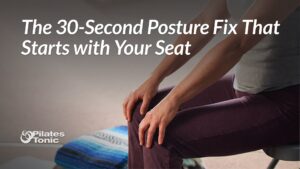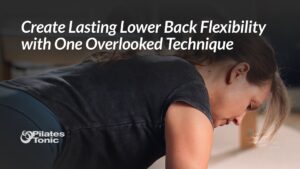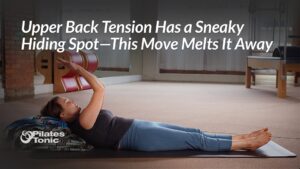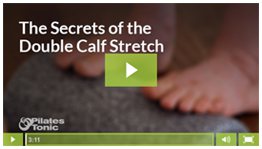Have you ever felt that your hip flexors just refused to relax? Ever wondered why your back was aching all the time? Are you struggling just to find your psoas?
Hip and back pain or tightness may actually be a problem with activating your psoas and today I'll show you how to solve this problem and get even greater benefit from all your exercise efforts—including Pilates, walking, running and more!
The psoas is one of the most important core muscles in our body, yet many of us never even realize it exists, let alone learn to develop it and activate it.
The Knee Float is a Great Psoas Activator if You Do It Right
One of the basic Pilates exercises that teaches you how to activate and strengthen your psoas is the knee float. The goal of a knee float is to connect to and use your psoas to lift your knee into the air.
It's your psoas which should be doing most of the work here, but in many cases it can actually end up doing nothing at all!
If we don't use the psoas, the hip flexors and quadriceps will tend to do the work instead and this can lead to a chronic feeling of tightness in the hip area and hip socket, back pain and bigger problems over time. It can even tighten the psoas itself.
If You Can Feel This, You're Not Using It
You can tell you're not using your psoas when you only feel the muscles in your leg and/or hip crease activate when holding your knees in a table-top position.
Don't worry, this is very common and I'm going to show you how to fix it in today's video. I'll show you specifically how to inhibit your quads so you can more easily connect with and use your psoas instead.
If you're not making the psoas connection, you are missing the benefits of many of the traditional Pilates mat exercises.
Once you really find and consistently connect to your psoas, you’ll know it because the way you walk, run and hold yourself will start to change.
Even if you think you already have a handle on your psoas connection, I really encourage you to try this technique and see how it works for you.
Let me know how it goes in the comments below, and remember, no question is too small!
See you in the studio,
Sydney
P.S. – Something big is coming in October! If you're a Pilates teacher, movement educator, or just a super Pilates/fitness geek in general (like me 🙂 ) you're going to love this special workshop on core ability. Stay tuned for more and mark your calendar for October 25th and 26th. 😉





38 Responses
how exactly should i use my lower abs and transverse muscles to lift my legs ?? i just happen to feel it in my legs. 🙁
Hi Mishie, Great question. For this exercise you want to find your psoas to lift your leg. Your psoas is located on the front of your spine, so it will feel like abdominal work when you connect with it to lift your knee. Your TA helps to stabilize your pelvis while your leg moves.
You might like to check out these other two videos. This one goes a little more in depth about the psoas. And this video goes more in depth about finding your TA. Thank you for your question!
Sydney!
Starting following you about 6 months ago, and your information is invaluable to me! I am certified in Mat, and teach at the Y. Certified through Balanced Body, and also have met Rebecca Leone. When you post your short videos, I read, re-read and watch, so I can use them in my classes. Love the TA smile! I tell class to smile with their face and their abs…get them to relax!
Thank you for your style of sharing!
Ginger
Hi Ginger, your feedback means the world to me. Thank you for sharing! 🙂
Hi Sydney, I have finally found what I believe is going to help me! Thank you! I am now sure that I have tight hip flexors that have caused no glutes on right side a weaker right leg. It believe its caused from too much sitting as my work requires me to sit 80% of the time over years. Yikes! I have gone to so many health practitioners and none of them have helped me… I have had xrays ct scan and nothing showed up.. weak hips it has to be. When I use the towel on my right leg I can feel the weakness when lifting leg.. I am currently working on your floor hip flexor release and think this exercise is best to do first to loosen up my flexors before I do other exercises? Thank you so much for sharing what you do..
Hi Andrea, the floor hip flexor stretch is perfect to do before other exercises, especially the knee floats. Thank you for sharing your feedback! I’m thrilled you have found the videos helpful!
Hi,
Thanks for the video. It gives me a hard time to find the psoas. Is it correct that I can feel the muscle in my upper leg contracting a bit? I can feel something is happening in the abdomen, so I guess that is right. I have some other question regarding the psoas. It seems like my psoas on the left side tightens the whole time. I use the constructive rest position and I can feel it relax. Afterwards I do gentle stretching and after a half an hour I get this burning like sensation in front of my hip again and it just does not go away, only again for a short period when I take the constructive rest position. Do you have any tips?
Thanks
Hi Arthur, sounds like you’re still feeling you’re hip crease with this exercise. But that’s normal at first, and it’s a good sign that you are feeling this in your abdomen as well! Check out where your weight is distributed in your feet when standing. If you stand with your weight in your heels, this can cause chronic tightness in the hip flexors. This video goes into more detail. Thanks for your question!
Thanks for the tip, I will give it a try. Ive been struggling with tight / weak hip flexors for ages. I really find table top difficult to maintain as my hips ache so much and cant raise my legs up to 90 degrees. I hope your exercise will help!
Hi Ian, You might also want to try stretching your hip flexors first. Here’s one of my favorite hip flexor stretches. Thanks for your feedback and good luck!
A few notes from me …
– If I squeeze too hard on the rolled up towel then my hip flexors and quads start to engage. To prevent this from happening I have to hold the towel really very lightly at the back of my knee. Is this normal?
– At first it was next to impossible to do the task without my hip flexors engaging. I use my fingers to check this, feeling for the contraction right at my hip joint. My first few efforts had the hip flexor coming on very strong and for a while I thought that doing this without engaging them wouldn’t ever work. However after a few efforts I started to engage my muscles in a different way, almost as if I was rolling my hips under, but by actually keeping my lower back still my knee would come up. Even still my hip flexor is grabbing a little bit when I do this, trying to do the work instead of my core.
I have had hip flexor pain for a few months now and it’s quite persistent. I suspect they are in an almost constant state of tension. This exercise actually brings me a bit of relief. Just my early observations would have me believe that I’ve got some significant dysfunction in this area so this exercise will hopefully help me a lot.
Thanks for the video and the instructions.
Hi Adam, These are great observations! Here’s a few other suggestions:
1. Holding the towel more lightly is perfect. You can also try thinking about holding the towel with the back of your leg. This makes it easier to relax the thigh.
2. I love using the image of a drinking straw as the front of my spine, and using the straw to slurp the top of my leg bone deeper into my pelvis before even considering lifting the leg.
Then I maintain that connection to lift my leg.
3. If you haven’t already, stretching your hip flexors before this exercise can make all the difference. Here’s a standing hip flexor stretch.
4. Lastly, practice consciously relaxing your kneecaps and quads, especially when you are feeling a lot of tension.
Your experience so far sounds completely normal. I think this exercise will get easier with practice. Thanks for sharing!
Thanks for the tips, I’ll put them into action.
Just to clarify: Is the aim to have absolutely no activation from your hip flexor? I can get less activation than normal, but it still seems incredibly difficult to get the leg to lift without it turning the hip flexor on just a little bit. Note that I am palpating quite deep into the hip joint and checking for even the slightest contraction. If the goal is for zero contraction then sure, I’ll keep trying that, but I wanted to check with you if maybe a little bit of contraction was still to be expected. Can you do it yourself with not even a hint of contraction?
Hi Adam, Sounds like it’s going really well. It’s not possible to isolate the psoas 100% for this exercise, so it’s completely fine if you are feeling a contraction in your hip joint. As long your strongest sensation for the effort is coming from the backside of your abdominals and you’re able to keep your pelvis still during the movement you’re good! Great Question!
OK, that really helps a lot. For anyone who doesn’t know where their hip flexor is then trying this exercise and not using your core will make it totally obvious. It’s like a band of muscle that pops up out of nowhere, quite wide across the front of the hip joint and can be really prominent if it activates fully. I find that sometimes when I first lie down it’s still activated and I have to take a few breaths and consciously let it go.
The difference I can make in this exercise is that if I don’t concentrate and get the movement right then my hip flexor switches on 100%, you can’t miss it. If I try to instead relax the hip flexor and activate my abdominals then I still get a slight increase in tightness, right in the pocket of the joint, but it’s definitely not like my whole hip flexor popping up and grabbing hold. I guess it makes sense that there is still some activity here, after all this is part of what it’s supposed to do, just not maybe quite so vigorously as it would be doing in the people who need to be using this exercise.
When I get it right it kind of feels like I’m moving my leg with my lower back, which is weird, but I’m guessing a good thing. Strange that using these muscles is so foreign to me!
This is fantastic feedback Adam! Thanks so much for sharing!
I love love LOVE this video! After years of Pilates at other studios I have FINALLY been able to identify my psoas with this video! Any chance you will create a 20-30 min fundamentals video for those of us who don’t live in your area?
Yay!! That’s fantastic Brooke! Thank you for sharing. We do have some fundamentals videos in the works and your feedback is super helpful! Make sure you sign up for the email mailing list to get details as they unfold. 🙂
G, Day, Thx for this, ive had pain in my groin area for ages, trail and error, ive worked out it is a tight right Posas affecting my hip flexors, and obliques, on that side, and thus refferred pain….this vid is great to isolate teh Posas for massage also…..side planks free up my hip flexors and then side stretches, with a large bottle of water as a weight, and pullofs(elastic on a door handle) both help with the obliques..im no expert, and i still have little idea which of these work and how , but a combination of these seems to help me …when i forget to do them, the pain in my right nugget comes back….and aslo tightens my butt musseles also….but i really think the root of the problem is the Posas…so i work out from here, with the hip eflexors and obliques also..Cheers!
Thanks for your feedback Mark! I’m glad this exercise was helpful!
Hi…my name is Isoke. I have been practicing yoga and lifting weights for years. U am pretty fit and very flexible. This year I developed a pain in my hip that feels like pirifomis syndrome ..the pain feels like a pull and a sweet ache from the inside of my right buttocks down my leg and across my lower back.I have been getting regular massages and I have been adjusted but nothing works long term. My yoga teacher says I use my hip flexors too much and suggested I try this exercise. I am committed to getting this technique
Hi Isoke, I’d love to hear how it goes!
Thank you for sharing this! After years of stretching and un-isolated exercises, this has truly made a big difference for me. Thank you!!
So glad you found this exercise helpful Danielle! Thanks for sharing!
why you call it”back side of abdominals”? i think i get your point but is a bit confusing, could you name it in another way please?
This is a great question Mxx! Your psoas muscles are located deep in your body. They are behind your abdominal muscles and internal organs, on the front side of your spine. I use the cue “backside of your abdominals”in hopes of getting you to look deep in your body to find the connection. Another way to say it would be to “look on the front of your spine”. Hope this helps! Thanks for your question.
Thank you so much for this video, it has really helped me visualise the action of the psoas. Would you have any suggestions for someone who needs to address a tight psoas problem but cannot lie supine, even with bent knees?
Hi Claire, Here’s a link to a standing hip flexor stretch you could try. Also, you mention not being able to lie supine with your knees bent, have you ever tried bolstering your upper body while supine? Here’s a link to a post by Katy Bowman that shows how to bolster the upper body for a psoas release. Hope these are helpful. Thank you for your feedback!
Hi Sydney,
I had a partial lenthening of the psoas a year ago and since then my psoas is struggling to function ,hip flexors are doing lots of work and I hope this will help reduce my overactive hip flexors. How many reps and days a week should this be done
Hi Andre, Check out this post from Katy Bowman. The exercise she demonstrates at the bottom of the post would be a great place to start first, and then revisit this exercise. Hope this is helpful. Thanks for your question!
I’m wondering how (if?) this could help me? My problem is that my obliques and psoas on the left are ALWAYS contracted, so much so that my torso leans to that side.
Hi Jenn, It sounds as though release/relaxation work for your left side would be a good idea before this exercise. It would be great if you could visit a Restorative Exercise™ Specialist or a Pilates instructor who specializes in therapeutic work. Thanks for your question!
Hi Sydney, My right psoas has been tensed for about at least three weeks now and I have been looking around a lot for stretch exercises but I found out that it probably needs to be released instead to start with. I tried your exercise once now and got pretty good contact with the psoas, not perfect but it worked ok for being the first time. The roll tips under the knee was very helpful. I felt a small snap in my right side so I guess I got that hip snap syndrome on top of a issue with the sacroiliac joint(my own guess with what I read). I have been feeling that snap sound in my right side before. Is it also good to activate the hamstring when doing this exercise before activating the psoas to get even more release of the psoas?
Thx for a very helpful video, best regards
Peter
Hi Peter, Here’s a blog post by Katy Bowman you might find helpful with regard to the snapping you’re feeling. At the bottom of her post she demonstrates a psoas release exercise that I’ve found is key. As far as hamstring activation, they will lightly activate to hold the towel behind your knee, which helps to keep the quads out of the movement. You could certainly try squeezing the towel tighter behind your knee to activate your hamstrings more and see how it feels. Thanks for your question!
Hi Sydney,
I am trying your exercise to access the psoas, but I find that my hip flexors hurt and it still seems like they are doing the work. Please advise!
Thank you,
Catherine
Hi Catherine,
Often stretching the hip flexors first can be very helpful. Here’s a couple stretches to try:
https://pilatestonic.com/2015/a-subtle-hip-flexor-stretch-that-releases-hidden-tightness/
https://pilatestonic.com/2013/pain-relieving-solo-hip-flexor-stretch-youll-love/
If it continues to hurt though I would discontinue the exercise. Thanks for your question!
Hi Sydney – whenever i try hip flexor exercises i find i use my tfl muscle on one side too much and then that becomes painful. Is this exercise exactly what i need to turn the tfl muscle off? Also when cycling i fine my tfl over worked.
Thank you 🙂
Hi Stuie! I think you’ll find this exercise helpful, and it’s definitely worth a try. Release work beforehand would be a good idea, though. Here’s an exercise to do first and then follow up with the knee floats from this video.
https://pilatestonic.com/2021/special-preview-your-glutes-are-connected-to-your-hip-flexors/
I’d love to hear how it goes. Thanks for your question!